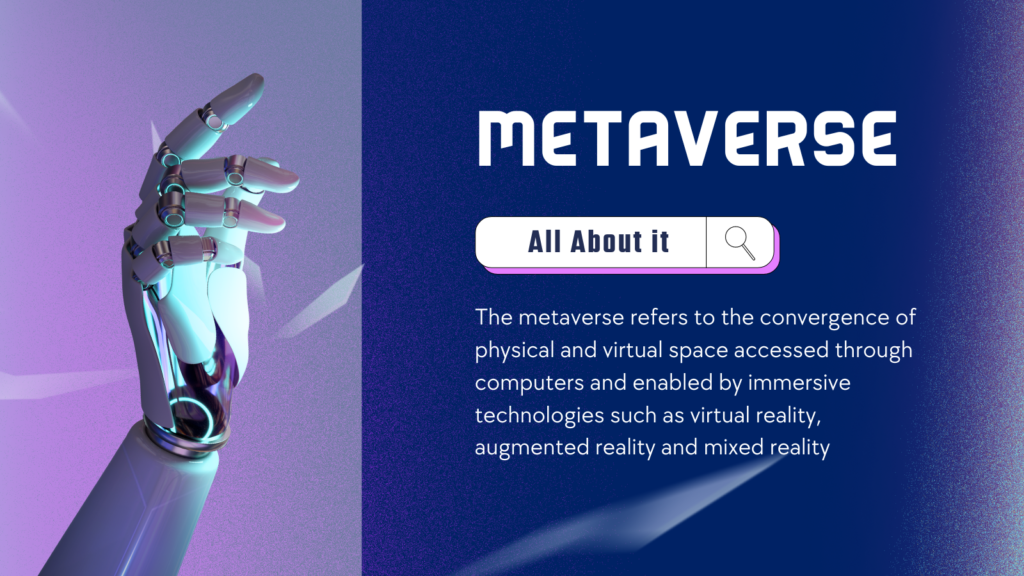TECHNOLOGY
The Future Path of Virtual Reality and Augmented Reality
Published
7 months agoon

Virtual Reality (VR) and Augmented Reality (AR) have swiftly emerged in recent years, heralding a new era of digital consumption. Their transformative power is not just groundbreaking, but awe-inspiring, as they reshape our digital experiences. VR immerses users in a virtual world. AR overlays digital info onto the real world.
These technologies have revolutionized gaming, education, healthcare, and even advertising. VR and AR continue to advance and grow. They will dominate digital content consumption in the future.
Join us to explore how VR and AR are shaping technology and changing how we interact with digital content.

The evolution of VR and AR technology:
VR and AR technology has come a long way since its inception. The evolution of these technologies has been nothing short of remarkable, with advancements in hardware and software leading to more realistic and immersive experiences for users.
Advancements in hardware and software have led to more realistic experiences for users. They are also more immersive. In the early days of VR, bulky headsets and weak processors made the technology hard for most people to use.
But, with the development of cheaper devices, VR and AR are now mainstream. One essential advancement in VR and AR is better display resolution and refresh rates. Early VR headsets had low resolution and refresh rates, which caused motion sickness and made virtual environments less realistic. But better displays and faster refresh rates have arrived. Now, users can see smooth and detailed visuals that are more convincing and engaging.
Another big advance in VR and AR technology is the development of easier, more natural user interfaces. Early VR and AR systems relied on clunky controllers or head-tracking systems, which made interacting with virtual environments feel awkward and unnatural. But hand tracking, eye tracking, and voice recognition have changed this. Now, users can interact with virtual objects and environments more easily and naturally. The accessibility of VR and AR technology has also been greatly improved in recent years.
Practical applications of VR and AR:
VR and AR have been making significant strides in many industries, providing tangible solutions to enhance customer experiences and streamline operations. This practicality is what sets them apart, making them more than just futuristic concepts.
VR and AR are not just futuristic concepts, they are already making a significant impact in healthcare. These technologies are being used for medical training, simulation, and patient care, revolutionizing the way healthcare professionals operate.
Healthcare professionals can now practice surgical procedures in a lifelike virtual environment. This allows them to refine their skills and improve patient outcomes. Patients can also enjoy VR therapy sessions. They help to reduce pain and anxiety during treatment. The education sector has also seen a considerable impact from VR and AR technologies.
Online classes and immersive learning are revolutionizing how students learn and engage with course material. Educators can create interactive lessons. They cater to different learning styles, making education more accessible and engaging. AR applications in education allow students to visualize complex concepts in a tangible way, promoting deeper understanding and memory.
In retail, VR and AR are changing how customers shop and engage with brands. Virtual showrooms and try-on experiences let shoppers preview products before buying. They cut the risk of returns and raise customer satisfaction.
Retailers can also use AR to improve in-store experiences. They can provide interactive displays and personal recommendations to shoppers. These technologies not only enhance customer experiences.

The impact of VR and AR on entertainment:
VR and AR have revolutionized entertainment. They offer immersive experiences once only possible in our wildest dreams. They have changed the way we consume entertainment. They provide a level of engagement and interactivity never seen before. They do this from gaming to storytelling.
Gaming has been one of the biggest beneficiaries of VR and AR technology. With VR headsets and controllers, gamers can step into a virtual world and interact with their environment in a way that feels very real. This immersion enhances the gaming experience, making players feel they are truly part of the game’s world.
AR has brought new life to traditional board games and mobile games. It turns the physical world into a playground for digital interactions. Also, ga, ming, VR, and AR have transformed how we experience storytelling. Immersive storytelling experiences let audiences step into a story. They can become a part of the narrative.
For example, VR films and interactive experiences let viewers explore different stories and perspectives, creating a more personal and engaging viewing experience. AR storytelling experiences blend the physical and digital worlds, allowing users to interact with characters and objects in real-time.
Challenges and opportunities in the VR and AR industry:
While VR and AR are rapidly growing and innovating, they also face several challenges. These include hardware limitations and high costs, which can hinder widespread adoption. However, the industry also presents significant opportunities for growth and innovation, particularly in the gaming and entertainment sectors.
One significant challenge facing the industry is hardware limitations. VR and AR devices need fancy tech to provide immersive experiences, but not all consumers have high-end devices. Also, the devices are expensive. This stops many potential users, limiting adoption.
Another challenge in the VR and AR industry is user adoption. Interest in VR and AR is growing. However, some users may hesitate to buy these devices. They worry about privacy, security, or discomfort when using the technology.
Key to boosting adoption rates is educating consumers about the benefits and safety of VR and AR. While VR and AR face challenges, the industry is ripe with opportunities for growth and innovation. Recognizing these opportunities is key to staying ahead in this dynamic field, especially in the gaming and entertainment sectors.
VR and AR technology could revolutionize how people experience media. They allow for more immersive and interactive content. Companies in this space can create new and fun experiences. They can appeal to a wide range of consumers.
The future of VR and AR devices:
The future of VR and AR devices is exciting. It is a rapidly changing landscape that keeps pushing the limits of technology. Consumers are getting used to immersive experiences. So, they want better hardware. See the latest VR and AR hardware trends, from headsets to accessories. See how they are evolving to meet consumer demands.
Headsets are critical to the VR and AR experience. Manufacturers always try to improve their comfort, resolution, and field of view. The latest headsets on the market have higher-resolution displays. They also have lightweight designs and adjustable straps for a more comfortable fit.
Eye-tracking technology and hand-tracking sensors are also advancing. They make virtual worlds more immersive and interactive for users. Accessories play a crucial role in enhancing the VR and AR experience. They are getting more advanced and easier to use. Examples include motion controllers and haptic feedback gloves. They allow for more natural and immersive interactions with virtual environments.
Companies are also finding new ways to add augmented reality to everyday objects, such as smart glasses and wearables. The goal is to create seamless and integrated experiences for consumers. A key trend in VR and AR hardware is the addition of AI and machine learning. They make the hardware work better and improve the user experience.
AI-powered tools can improve graphics rendering. They can reduce motion sickness and make virtual environments more realistic. These technologies continue to evolve. We expect to see more innovative and responsive VR and AR devices. They will adapt to each user’s preferences and behavior.
Embracing the potential of VR and AR in marketing:
Today’s world is more digital. Virtual reality (VR) and augmented reality (AR) are emerging as powerful tools. They help businesses create engaging marketing campaigns and connect with their audience in new and exciting ways. Companies can embrace VR and AR. This will set them apart from competitors. It will immerse consumers.
Using VR and AR in marketing campaigns lets businesses make stunning, interactive experiences. The experiences captivate and engage their audience. Companies can immerse consumers in virtual environments and overlay digital content onto the physical world, demonstrating their products and services more impactfully and memorable.
This increases brand awareness. It also creates a deeper connection with customers. VR and AR in marketing have a crucial benefit. They let us create personalized and interactive experiences for consumers. By using these technologies, businesses can tailor content to fit individual preferences and interests, providing a more targeted and engaging experience. This customization level boosts consumer happiness. It also raises the chance of conversion and brand loyalty.
Furthermore, VR and AR can drive customer engagement in ways that were not possible before. For example, companies can create virtual stores. They let customers explore and interact with 3D products before deciding to buy. This improves shopping. It also keeps customers happy and coming back.
Ethical considerations in VR and AR development:
VR and AR technologies are gaining traction in many industries. People use them in gaming, entertainment, healthcare, and education. However, the VR and AR development boom has brought many ethical issues. Developers must address them.
One of the major concerns surrounding VR and AR technology is privacy. These experiences may collect and use users’ data without their knowledge. Developers must rank data protection and transparency. This will ensure that we respect user privacy.
Another ethical issue concerns VR and AR tech. They might harm mental health. Immersive experiences can blur reality and virtual worlds. This blurring leads to issues such as addiction and dissociation. Developers must add safeguards. These include time limits and breaks. They prevent users from becoming too immersed in virtual worlds.
Additionally, developers should research the effects of VR and AR on the mind and adjust their designs to prioritize user well-being. To address these ethical concerns, developers must prioritize user consent and control. Users should be able to opt out of data collection and easily understand how their data is used.
Developers should also prioritize user safety. They can do this by adding features such as age limits and parental controls. Putting user interests first builds trust and credibility, and it can do so in the VR and AR industry. Developers should also talk to stakeholders and experts to ensure that their designs follow ethical standards.
The role of VR and AR in remote collaboration:
After COVID-19, remote work has become the norm for many global businesses. As a result, the need for practical remote collaboration tools has never been greater. VR and AR tech are powerful. They bridge the gap between remote teams. These new technologies let teams collaborate and interact in a virtual space. They work no matter where the teams are.
Enabling Remote Collaboration and Communication
VR and AR technology are revolutionizing remote collaboration by providing users with immersive and interactive experiences. With VR headsets, team members can enter a shared virtual environment. There, they can work on projects together, generate ideas, and have meetings as if they were in the same room.
AR technology overlays digital information onto the real world, allowing team members to interact with virtual objects in their space. This depth of immersion and interactivity improves communication and teamwork. It leads to higher productivity and efficiency.
Post-Pandemic World
In a post-pandemic world, remote work is becoming more common. VR and AR tech are crucial. They ensure teams can work well together, no matter where they are.
These technologies are breaking down distance barriers. They let team members connect and work together in a way that was not possible before.
Conclusion:
The article highlights the big advances of Virtual Reality (VR) and Augmented Reality (AR) and notes their potential. They are changing how we engage with digital content. It has uses in gaming. It also has uses in many industries. The possibilities seem endless. VR and AR are evolving and improving.
We can expect to see even more innovative uses. These uses will enhance our daily lives.The future of VR and AR is promising. It is exciting to see how these technologies will continue to change how we interact online.

I aim to bring you informative and engaging content. With a passion for staying ahead of the curve in the fast-paced world of technology, my goal is to provide readers with in-depth analysis, reviews, and updates on the latest trends and innovations.
I aim to bring you informative and engaging content. With a passion for staying ahead of the curve in the fast-paced world of technology, my goal is to provide readers with in-depth analysis, reviews, and updates on the latest trends and innovations.

TECHNOLOGY
Integrated or Dedicated Graphics: Find Your Perfect Match
Published
6 months agoon
21 May 2024
Graphics cards are a vital part of modern computing. They are essential for gamers and tech enthusiasts. You may be building a gaming PC or need a reliable setup for everyday use.
You need to understand the differences between integrated and dedicated graphics cards. Within this guide, we’ll present all of the knowledge necessary for success. It will help you make an informed decision.
Graphics Cards: Their Role and Importance
Graphics cards, also known as GPUs, are special hardware. Rendering images, videos, and animations is their primary function. They play a crucial part in a variety of applications.
- Gaming offers high-quality graphics and smooth frame rates.
- Professional Work: Video editing, 3D rendering, and graphic design.
- Everyday Use: Improving the visual experience for general tasks.
Your computer needs a dedicated graphics card. It relies on the integrated graphics processor (IGP) in the CPU. This may work for basic tasks like web browsing and word processing. But it can’t handle demanding applications.

Understanding Integrated Graphics Cards: Pros and Cons
What are integrated graphics cards?
The motherboard, or CPU itself, houses integrated graphics cards. Often found in laptops and budget desktops, they share the system’s RAM. We refer to Intel’s integrated graphics processors as Intel HD Graphics and Intel UHD Graphics. AMD calls it Radeon Vega or Ryzen Vega.
Technical Differences
- Shared Memory: Integrated GPUs use the system’s main memory instead of having their own.
- Lower Power Consumption: They use less power, making them ideal for portable devices.
Pros
- Cost-Efficiency: Integrated GPUs reduce the computer’s cost.
- Lower Power Requirements: Ideal for energy-efficient systems.
- Compact Design: Perfect for laptops and small form-factor PCs.
Cons
- Limited Performance: Not suitable for high-end gaming or professional graphic work.
- Shared resources: Using system RAM can slow down performance.
- Upgradability: To upgrade it independently, you will need a new CPU or motherboard.
Exploring Dedicated Graphics Cards: Advantages and Limitations
What are dedicated graphics cards?
Dedicated graphics cards are standalone units. They possess their own memory (VRAM), which is installed on the motherboard.
Technical Differences
- Dedicated Memory: VRAM speeds up the processing of graphical tasks.
- Enhanced Performance: Higher clock speeds and more cores compared to integrated GPUs.
- More Power Consumption: Dedicated GPUs must have more power and heat management.
Pros
- Superior Performance: Essential for gaming, 3D rendering, and other intensive tasks.
- Customisation and Upgradability: Easier to Upgrade or Replace.
- Better Cooling Solutions: Often, they come with advanced cooling mechanisms.
Cons
- Higher costs: These are more expensive than integrated solutions.
- Increased Power Consumption: This requires more power and, often, more cooling.
- It may not fit in all computer cases due to its larger size.
Critical Differences Between Integrated and Dedicated Graphics Cards
Performance
- The integrated system is adequate for basic tasks and light gaming.
- A dedicated system is necessary for demanding applications and high-end gaming.
Cost
- A budget-friendly option is integrated.
- Dedicated: More expensive due to dedicated memory and higher performance.
Power Consumption
- The integrated feature offers lower power consumption, making it suitable for portable devices.
- The dedicated system uses more power and produces more heat.
Upgradability
- Integrated: limited or no upgradability.
- Dedicated: Easier to upgrade or replace with newer models.
Use Cases
- Integrated: Ideal for everyday computing, media consumption, and casual gaming.
- Dedicated: Ideal for gaming, professional work, and any application requiring high graphical power.
Graphics Cards for Gaming: Performance Metrics and Considerations
Important performance metrics
- Frame Rate (FPS): A higher FPS ensures smoother gameplay.
- Resolution: Dedicated GPUs handle higher resolutions better (e.g., 1440p, 4K).
- In texture-heavy games, more VRAM means better performance.
- Clock Speed: Higher clock speeds improve performance.
Gaming Benchmarks
- Integrated GPUs typically support 720p to 1080p gaming with lower settings.
- Dedicated GPUs: Can handle 1080p to 4K gaming with high to ultra settings.
Considerations for Gaming
- Game Settings: Integrated GPUs may struggle with high graphics settings.
- Dedicated GPUs offer more longevity and future-proofing for gaming needs.
- When choosing a graphics card, consider your budget and gaming preferences.
Example
- NVIDIA GeForce GTX 1650: A budget-friendly dedicated GPU capable of 1080p gaming.
- Intel UHD Graphics 620: An integrated GPU suitable for light gaming and media.
Graphics cards for professional work: considerations and recommendations
Applications That Benefit from Dedicated GPUs
- Video editing offers smooth playback and faster rendering.
- 3D Rendering: Complex tasks must have dedicated graphics power.
- Graphic design encompasses the creation of high-quality images, animations, and visual effects.
Consider dedicated GPUs.
- NVIDIA Quadro RTX 4000: A high-end GPU optimized to handle heavy workloads.
- AMD Radeon Pro WX 7100: Optimised for heavy video editing, 3D rendering, and design workloads.
Considerations for Professional Work
- Consider your budget. Also, consider the apps you’ll use when choosing a graphics card.
- System Requirements: For optimal performance, certain applications may require specific hardware or software.
- Future Upgradability: Consider investing in a higher-end GPU for future upgrades and longevity.
Graphics Cards for General Use: Cost-Efficiency and Everyday Performance
Everyday Tasks
- Web Browsing: Both integrated and dedicated GPUs handle it well.
- Media Streaming: For HD streaming, integrated GPUs are sufficient.
- Office Applications: Minimal graphical power is required, making integrated solutions cheap.
Cost vs. value
- Integrated GPUs provide excellent value for non-intensive tasks.
- Dedicated GPUs: Provide a better long-term investment for users seeking high performance.
Future trends in graphics card technology
Ray tracing and AI
- Ray Tracing: Enhanced lighting effects for more realistic graphics.
- AI Enhancements: AI-driven features like NVIDIA’s DLSS (Deep Learning Super Sampling).
Advances in Integrated Graphics
- Intel Iris Xe: Bringing better performance to integrated solutions.
- AMD Ryzen APUs: Combining strong CPU and GPU performance in one chip.
Sustainability Initiatives
- Energy Efficiency: Researchers are designing new GPUs to be more energy-efficient.
- Recycling Programs: Companies such as NVIDIA and AMD promote recycling old hardware.
You must choose between an integrated and a dedicated graphics card. The choice depends mostly on your needs and budget. Here are a few final tips to help you decide:
- Identify Your Use Case: A dedicated GPU is necessary if gaming or professional graphic work is a priority.
- Consider Budget Constraints: For general use, an integrated GPU is cost-effective.
- Think long-term: Buying a dedicated GPU could future-proof your setup even if you don’t need high performance now.
Understand these differences and trends. Then, you can make an informed decision that fits your needs.

I aim to bring you informative and engaging content. With a passion for staying ahead of the curve in the fast-paced world of technology, my goal is to provide readers with in-depth analysis, reviews, and updates on the latest trends and innovations.
TECHNOLOGY
Unlock Gaming Performance With The Ideal CPU Architecture
Published
6 months agoon
18 May 2024
The Central Processing Unit (CPU) is your machine’s brain in computing. It executes commands and manages tasks quickly and efficiently. Tech enthusiasts and gamers enjoy understanding CPU architectures. It can significantly improve their computing. It helps with everything, from daily tasks to intense gaming. But what exactly is CPU architecture, and why does it matter?
CPU architecture refers to the design and organization of the processor’s parts. It’s about how they interact. It’s not just about clock speeds and core counts. The architecture dictates how well a CPU can perform.
It affects everything, from multitasking to rendering your favourite games. In this post, we’ll explore different CPU architectures and their impact on speed. We’ll also offer practical advice on choosing the right CPU for your needs.

Common CPU architectures
x86 Architecture
Intel developed the x86 architecture. It has been a cornerstone of personal computing for decades. x86 processors are known for their versatility and firm performance. They excel in many applications, from desktop computing to gaming. Key features include the ability to handle complex instructions. It also supports high-performance multithreading.
Here’s a real-life example. Intel’s Core i9 processors use the x86 architecture. They are famous for their strong performance on gaming PCs. They deliver smooth gameplay and high frame rates.
ARM Architecture
The Advanced RISC Machine architecture is different. It is designed for efficiency. Mobile devices and tablets primarily use ARM processors. They are known for using little power and being very efficient. This architecture is gaining traction in other areas. This includes laptops and even servers. It’s because it can deliver outstanding performance with little energy.
Apple’s M1 chip, based on the ARM architecture, is a practical example. It shows excellent performance in everyday tasks and demanding applications. It also maintains good energy efficiency.
RISC-V Architecture
RISC-V is an open-source architecture. It is gaining popularity for its flexibility and potential for customization. It is less widespread than x86 or ARM. But RISC-V offers something unique. This is an advantage for developers. They want to tailor processors to specific applications.
For example, SiFive makes RISC-V processors. They are for embedded systems and IoT devices.
Choosing the Right CPU Architecture for Gaming
When gaming, picking the right CPU design can significantly affect performance. For a long time, x86 processors have dominated this market. However, newer architectures like ARM and RISC-V are gaining traction. Here are some factors to consider: They will help you decide on the best architecture for your gaming needs.
- The x86 architecture is the design platform for many games. Therefore, you may need assistance with other architectures. However, the gaming industry is becoming more inclusive toward non-x86 processors.
- Gamers often have many apps open while playing. So, they need a processor with intense multitasking and multithreading, like an x86. This allows for smoother gameplay without sacrificing system performance.
- Power Efficiency: If you’re a mobile gamer or value energy efficiency, ARM and RISC-V may be better for you. These processors are ranked for power efficiency. This allows for longer battery life while still delivering excellent gaming performance.
- The price varies depending on the processor and its capabilities. Different architectures can have different prices. Consider your budget when choosing between x86, ARM, or RISC-V processors.
Impact on Performance
The exemplary CPU architecture can significantly affect gaming performance. It determines how well your processor can handle tasks and instructions. x86 processors have long been the go-to choice for gamers. But newer architectures like ARM and RISC-V are catching up in raw speed.
Single-Threaded vs. Multi-Threaded Tasks
The CPU architecture is critical. It determines how well a processor handles tasks. Single-threaded tasks are common in many everyday applications. They rely on the individual cores’ speed. Tasks use many threads. They are common in gaming and professional software. They enjoy working together on many cores. Architectures like ARM are great at handling one thread. In contrast, x86 and RISC-V offer strong multithreading.
Overclocking Potential
Overclocking increases a CPU’s clock speed. It goes beyond its default setting. It is another factor to consider when assessing performance. Overclocking is the focus of architectures like x86 and ARM. RISC-V processors may be more flexible due to their open-source nature. But overclocking can also increase power consumption. It can also damage the processor if done incorrectly.
Graphics Performance
Graphics performance is another area where CPU architecture can make a significant impact. High-resolution displays and immersive gaming are on the rise. The need for quality graphic designs is greater than ever. A dedicated graphics card is crucial. However, the CPU also helps with graphics performance. Many new architectures, such as ARM and RISC-V, have built-in graphics. They can easily handle demanding games.
In gaming, a CPU with strong single-threaded performance will deliver smooth gameplay. This holds for titles that lack multithreading optimization. A processor with good multi-threaded abilities will do well. It will excel in modern games that use multiple cores.
Beyond Architecture
While architecture is crucial, several other factors influence CPU performance.
- We measure the processor’s clock speed in GHz. Its core count also affects performance.
- CPU cache is high-speed memory. It stores often-used data, allowing for faster processing. The size and speed of the cache can affect performance.
- Overclocking can improve performance. However, one must exercise caution to prevent any damage to the processor.
- These are extra sets of instructions. Processors can process them better. They improve performance on specific tasks.
- Overclocking and demanding applications create a lot of heat. It would help if you had proper cooling to prevent throttling.
- Clock Speed: Increased clock speeds translate into more efficient processing. However, efficiency also depends on how well the architecture uses these speeds.
- Cache Size: Bigger caches can store more data for quick access. This reduces the time required to retrieve data from the main memory.
- Thermal Design Power (TDP) is lower. It shows better energy efficiency. This is crucial for maintaining performance without overheating.
Future trends in CPU design
Efficient Designs
CPUs are leaning towards designs that balance speed with efficiency. Innovations are leading to faster and less powerful processors. This is crucial for mobile computing and extending battery life.
Emerging Architectures
The new architectures, like Intel’s Alder Lake and ARM’s Cortex-X series, will push CPU limits. These designs focus on hybrid approaches. They combine fast cores with efficient ones to optimize for varied workloads.
Increased parallel processing
The rise of artificial intelligence and machine learning makes parallel processing more critical. Many new processors can handle complex tasks at the same time. This dramatically boosts their performance in these areas.
Open-source designs
Open-source CPU architectures, such as RISC-V, are gaining traction. This is due to their flexibility and customization capabilities. These designs allow for more collaboration and innovation. They lead to unique and powerful processors.
The RISC-V M-Class is a low-power CPU design. It is ideal for microcontrollers in Internet of Things (IoT) devices. It shows the potential for specialized CPUs in this architecture.
Impact on Consumer Technology
CPU architectures are evolving. Consumers can expect more powerful and efficient devices. These devices will be gaming rigs and everyday laptops. The shift to efficient designs will also enable thinner, lighter devices. They won’t compromise on performance. This shift will enhance portability and the user experience.

Practical Advice for Consumers
When it comes to choosing a CPU, there is no one-size-fits-all solution. Consumers must consider their specific needs and budget to make an informed decision. Here are some practical tips to keep in mind when selecting a processor.
- Know your use case: If you’re a gamer, prioritize single-threaded performance. For professional use, multithreading capabilities are essential.
- Don’t overspend. Pricier processors may need more performance. So, compare benchmarks and keep in mind your budget.
- Think about future needs. If you plan to keep your device for a long time, it may be worth investing in a more robust processor now. This will ensure it can handle future updates and software requirements.
- Ensure compatibility. Check that the CPU you choose works with your motherboard and other components.
- Do your research. Understand the specifications and read reviews. They will give you a better idea of how a processor performs in the real world.
Choosing the Right CPU Architecture
When selecting a CPU, consider your primary use cases:
- Look for CPUs with single-threaded solid performance and high clock speeds for gaming. This includes chips like Intel’s Core i9 or AMD’s Ryzen 9.
- Balanced CPUs like Intel’s Core i5 or AMD’s Ryzen 5 have good value. They offer solid performance for everyday tasks.
- Mobile Devices: Laptops and tablets use ARM-based processors like Apple’s M1. They offer a blend of speed and energy efficiency.
Upgrading and overclocking
If you plan to upgrade your CPU or overclock, do thorough research. Follow safe practices to avoid damage. Additionally, you should monitor the temperature constantly and invest in proper cooling solutions for optimal performance.
Staying Informed
Technology is advancing. It’s essential to stay updated on the latest CPU architecture. Research trusted sources for information. These include industry websites, as well as reviews from professionals and users. Staying current with the latest trends can help you make informed decisions. This occurs when purchasing devices or upgrading components.
Understanding technical specifications
Familiarize yourself with key specifications:
- Cores and Threads: With more cores and threads, you can handle more tasks at the same time. This is beneficial for multi-threaded applications.
- Clock speed indicates how fast a core can process instructions. Higher speeds mean better performance.
- Cache Size: An enormous cache can speed up processing. It accomplishes this by storing frequently used data near the CPU.
Future-Proofing Your Technology
Consider long-term needs when choosing a CPU.
- Upgrade Path: Ensure your motherboard supports future CPU upgrades.
- Compatibility: Check compatibility with other components, such as RAM and GPUs.
- Performance Headroom is critical. Choose a CPU that surpasses your current needs. It should be able to handle future software demands.
Understanding CPU architecture is essential for making informed decisions about your computing hardware. It applies to gaming and general computing.
The right CPU can significantly improve your experience. It does this by providing the needed performance and efficiency. CPU designs continue to evolve. Staying informed about the latest trends will help you protect your technology investments.

I aim to bring you informative and engaging content. With a passion for staying ahead of the curve in the fast-paced world of technology, my goal is to provide readers with in-depth analysis, reviews, and updates on the latest trends and innovations.
TECHNOLOGY
SSD vs. HDD: The Superior Storage Option for Your Needs
Published
6 months agoon
16 May 2024
When it comes to gaming, every millisecond counts. The type of storage you pick can hugely affect gaming performance. It can impact loading times, game performance, and how long your device lasts. This post compares solid-state drives (SSDs) and hard disc drives (HDDs). It will help you choose the best gaming storage for your needs.

Introduction to SSDs and HDDs
What is an SSD?
A solid-state drive (SSD) is a storage device that uses NAND-based flash memory to store data. SSDs are unlike traditional HDDs. They have no moving parts. This allows for faster data access and superior durability. SSDs are known for their lightning-fast read and write speeds. They make them perfect for performance-focused applications.
What is a hard disc drive?
A hard disc drive (HDD) is a storage device. It uses spinning discs coated with magnetic material to store data. A moving read/write head reads and writes data. HDDs are slower than SSDs. Nonetheless, they have more storage at a lower cost per gigabyte. This makes them suitable for bulk storage.
Read/Write Operations: Speed and Performance
SSD:
- Speed: SSDs are known for their exceptional speed. They use flash memory to store data. It allows for much faster reading and writing than hard disc drives. This translates to quicker game load times and faster file transfers.
- SSDs have no moving parts. They can access data almost instantly. This provides a smoother gaming experience.
HDD:
- HDDs are slower than SSDs. They use spinning discs to read and write data. This can result in longer load times and slower performance during gaming.
- HDDs are mechanical, so they are prone to latency and lag. This can hurt fast-paced games.
Capacity and Cost per Gigabyte
SSD:
- SSDs have been catching up. But they still offer less storage per dollar than hard drives.
- Cost per Gigabyte: SSDs are more expensive than HDDs. Recent data shows that SSDs cost more per gigabyte. This makes them a pricier option for gamers who want a lot of storage.
HDD:
- Capacity: HDDs offer larger storage capacities at a lower cost. You can easily find HDDs with many terabytes of storage. This is ideal for gamers with extensive game collections.
- Cost per Gigabyte: HDDs are cheaper. They are a cost-effective solution for significant storage needs.
Cost per gigabyte table:
Storage Type: Average Cost per Gigabyte
|————–|———————-|
SSD | $0.10 to $0.20 |
Corrected: HDD: $0.03 to $0.05
Durability and longevity
SSD:
- SSDs are more durable. Drops and shocks are less likely to damage them because they lack moving parts.
- SSDs have a limited number of write cycles. Modern ones, on the other hand, are designed to last for years under everyday gaming use.
HDD:
- Durability: HDDs are more fragile due to their mechanical components. Drops and physical shocks can cause data loss or drive failure.
- HDDs can wear out over time. This is particularly true when they undergo frequent read-write operations. However, they can still last many years if properly maintained.
Portable Devices' Power Consumption and Battery Life Impact
SSD:
- SSDs consume less power than HDDs. This makes them better for gaming laptops and portable devices.
- SSDs use less power. This makes their batteries last longer. This is critical for gamers on the go.
HDD:
- HDDs consume more power due to their moving parts. This can drain the battery faster on portable devices.
- Using an HDD can cut the battery life of gaming laptops. This affects mobility and gaming away from power sources.
Power Consumption Table:
Storage Type | Average Power Consumption
|————–|—————————|
SSD: 2–3 Watts
HDD: 6-7 watts.
Noise level and heat generation
SSD:
- Noise Level: SSDs operate quietly because they have no moving parts.
- SSDs generate less heat. This can make for a cooler and quieter gaming environment.
HDD:
- Noise Level: HDDs can be noisy due to their spinning discs and moving read/write heads.
- HDDs generate more heat. This heat can affect your gaming setup’s temperature.

Suitability for Different Use Cases
SSD:
- Gamers who prioritize speed, performance, and durability are ideal. If you play fast-paced games, an SSD will give you the best experience. It has quick load times and responsive gameplay.
- Use cases include competitive gaming and virtual reality. They also include any scenario where performance is critical.
HDD:
- Ideal for gamers who require large storage capacities at a reasonable price. If you have a vast library of games and are okay with slightly longer load times, an HDD is a cost-effective solution.
- Casual gaming, storing large game libraries, and use cases where budget is a concern.
A Comprehensive Analysis of Various User Types
Tech Enthusiasts
For tech enthusiasts, SSDs are the clear winner. They value cutting-edge technology and performance. SSDs have quick data access speeds and are durable. This makes them ideal for running virtual machines. They are also great for large-scale software development and other intensive tasks.
Testimonial:
“Switching to an SSD has revolutionised my workflow. Everything is much faster. My system boots up faster, and I can run complex simulations faster.” Alex, tech enthusiast.
Gamers
SSDs facilitate fast load times and smooth gameplay for gamers. An SSD upgrade cuts game loading times a lot. It also boosts gaming performance.
Testimonial:
“After switching to an SSD, my games load almost instantly, and I experience far fewer lag spikes. It’s a game-changer.” Jamie, Gamer.
Small business owners
Small business owners often need a balance between performance and cost. Upgrading to SSDs can boost productivity. They achieve this by reducing boot times and increasing data access. Fast access is crucial for running business apps well.
Data Centres
Data centers and organizations require massive amounts of storage for backups and long-term data. HDDs are a cheap solution. HDDs have a high capacity and are cheap per gigabyte. These traits make them suitable for these use cases, despite lacking the speed of SSDs.
Future trends in storage technology
Technology continues to evolve. The gap between SSD and HDD capabilities is narrowing. New technologies, such as NVMe, are pushing SSDs further. Advances in HDDs are increasing capacities and cutting costs.
Looking ahead, we can expect:
- More people are using solid-state drives. As costs fall, solid-state drives will become more affordable. This will encourage wider usage by all types of users.
- Hybrid solutions are fast. They combine solid-state drives’ speed with hard disc drives’ capacity. They offer the best of both worlds.
- NAND technology is advancing. New developments in NAND flash memory will improve SSDs. They will make it faster and more difficult.
Conclusion: Which storage solution is right for you?
The choice between SSD and HDD depends on your needs and circumstances.
- If you wish, choose SSD.
- High performance
- Faster load times
- more durable storage.
- SSDs are ideal for competitive gamers, as well as those who value speed and efficiency.
- Choose an HDD if you need large storage capacity at a lower cost. HDDs are suitable for casual gamers. They are also good for those who have lots of games. But they must be willing to trade off speed for storage space.
Understand the strengths and weaknesses of both storage solutions. Then, you can make an informed choice. It will improve your gaming.
Ready to upgrade your gaming setup? Consider your priorities. Choose the storage solution that best fits your gaming style and needs. Happy gaming!

I aim to bring you informative and engaging content. With a passion for staying ahead of the curve in the fast-paced world of technology, my goal is to provide readers with in-depth analysis, reviews, and updates on the latest trends and innovations.
Trending
-

 GUIDE7 months ago
GUIDE7 months agoHow to Add Subtitles to YouTube Videos: A Comprehensive Guide
-

 GUIDE6 months ago
GUIDE6 months agoHow to Connect Airpods to Android
-

 GUIDE5 months ago
GUIDE5 months agoHow to Shutdown a PC or Laptop Using a Keyboard
-

 GUIDE5 months ago
GUIDE5 months agoBest Android Games to Play in 2024
-

 TECHNOLOGY6 months ago
TECHNOLOGY6 months agoSSD vs. HDD: The Superior Storage Option for Your Needs
-

 GUIDE6 months ago
GUIDE6 months agoBlock Spam Emails in Gmail: Simple Tricks That Work
-

 TECHNOLOGY6 months ago
TECHNOLOGY6 months agoUnlock Gaming Performance With The Ideal CPU Architecture
-

 GUIDE5 months ago
GUIDE5 months agoHow To Change Background Color On Instagram Story
Walter Cozzy
13 May 2024 at 17:27
Thanks for this informative article. It was packed with information and provided great insights.